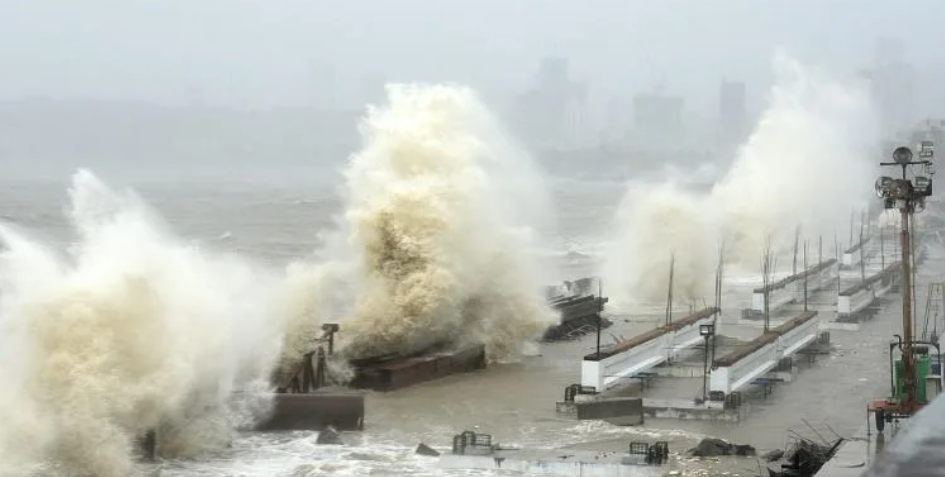At least 21 people were dead and 96 were missing on Tuesday after a monster cyclone slammed into western India, compounding the misery for millions of others who are enduring a devastating coronavirus surge.
Hundreds of thousands of people were without power after Cyclone Tauktae, one of a growing number of increasingly severe storms in the Arabian Sea blamed on climate change, hammered the Gujarat coast on Monday evening.
The cyclone packed gusts of up to 185 kilometres (115 miles) per hour, uprooting trees and knocking down power lines and mobile phone towers as it barrelled inland while weakening slightly.
One support vessel serving oil rigs that were hit by immense waves off the coast of Mumbai sank and 96 of the 273 people who had been on board were missing, the Indian Navy said Tuesday.
The defence ministry said 177 people were rescued from the vessel, with operations expected to continue throughout the day in “extremely challenging sea conditions”.
Elsewhere one fresh casualty was reported on Tuesday, taking the confirmed death toll to at least 21 as savage winds swept through flimsy homes and turned streets into rivers.
Although the cyclone was one of the fiercest to hit the area in decades, better forecasting than in recent years allowed for strong preparations, and more than 200,000 people in danger zones were evacuated from their homes.
Mumbai authorities on Monday closed the airport for several hours and urged people to stay indoors as huge waves battered the city’s seafront.
– Covid catastrophe –
The deadly weather system has hindered India’s embattled response to a coronavirus surge that is killing at least 4,000 people daily, and pushing the health system to breaking point.
Mumbai shifted on Sunday about 600 Covid-19 patients in field hospitals “to safer locations”, while sea levels swelled as high as three metres (10 feet) near the seaside town of Diu.
In Gujarat, where all Covid-19 patients in hospitals within five kilometres of the coast were also moved.
But one Covid patient died in the town of Mahuva after he could not be moved in time before the storm hit, doctors said.
Authorities there scrambled to ensure there would be no power cuts in the nearly 400 designated Covid hospitals and 41 oxygen plants in the area.
More than 1,000 Covid hospitals in coastal towns had been provided with generators, chief minister Vijay Rupani told reporters.
The state also suspended vaccinations for two days. Mumbai did the same for one day.
– Terrible double blow –
“This cyclone is a terrible double blow for millions of people in India whose families have been struck down by record Covid infections and deaths,” said Udaya Regmi from the International Federation of Red Cross and Red Crescent Societies.
The organisation said it was helping authorities to evacuate people most at risk in coastal areas, providing first aid, masks “and encouraging other critical Covid-19 prevention measures”.
Last May, more than 110 people died after “super cyclone” Amphan ravaged eastern India and Bangladesh in the Bay of Bengal.
The Arabian Sea previously experienced fewer severe cyclones than the Bay of Bengal but rising water temperatures because of global warming was changing that, Roxy Mathew Koll from the Indian Institute of Tropical Meteorology told AFP.
“(The) Arabian Sea is one of the fastest-warming basins across the global oceans,” he said.
The effects were felt far and wide with authorities in Nepal, some 2,000 kilometres (1,200 miles) from Gujarat, advising climbers on Everest and other mountains to stay put.
But more than 200 climbers ignored the warnings and were heading up Everest, eyeing for the summit end of this week, a government official at the base camp said.
“I had already decided to wait for summit after the 24th because the jet wind was in our region. Now the cyclone is also bringing moisture and possibly snow with it,” Dawa Steven Sherpa of expedition organiser Asian Trekking told AFP.
The cyclone was expected to bring substantial rains as far away as Delhi, more than 1,200 kilometres (750 miles) from the Gujarat coast and to Uttarakhand on the Himalayan border with Tibet.



Comments are closed.